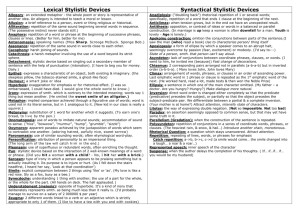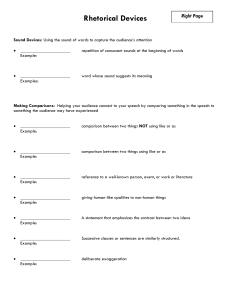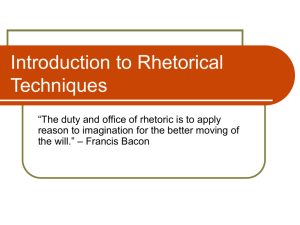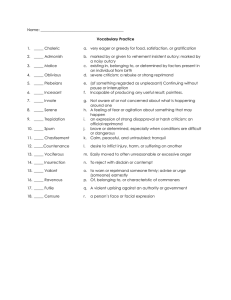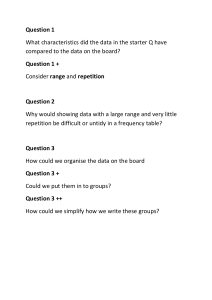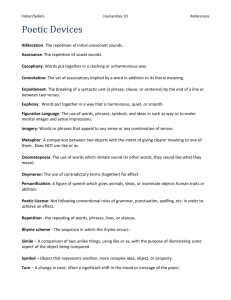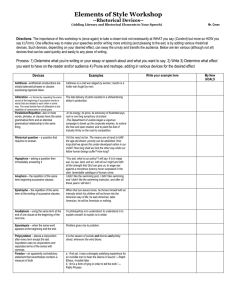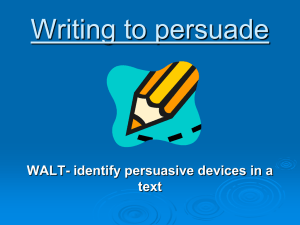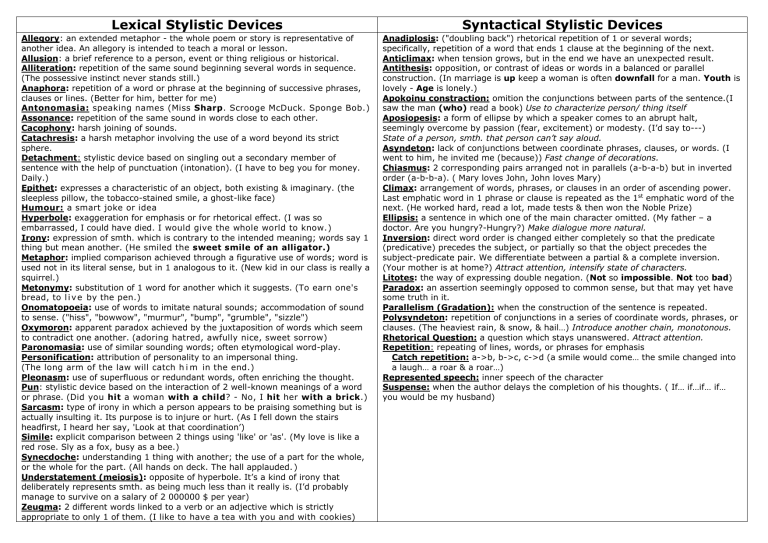
Lexical Stylistic Devices Syntactical Stylistic Devices Allegory: an extended metaphor - the whole poem or story is representative of another idea. An allegory is intended to teach a moral or lesson. Allusion: a brief reference to a person, event or thing religious or historical. Alliteration: repetition of the same sound beginning several words in sequence. (The possessive instinct never stands still.) Anaphora: repetition of a word or phrase at the beginning of successive phrases, clauses or lines. (Better for him, better for me) Antonomasia: speaking names (Miss Sharp. Scrooge McDuck. Sponge Bob.) Assonance: repetition of the same sound in words close to each other. Cacophony: harsh joining of sounds. Catachresis: a harsh metaphor involving the use of a word beyond its strict sphere. Detachment: stylistic device based on singling out a secondary member of sentence with the help of punctuation (intonation). (I have to beg you for money. Daily.) Epithet: expresses a characteristic of an object, both existing & imaginary. (the sleepless pillow, the tobacco-stained smile, a ghost-like face) Humour: a smart joke or idea Hyperbole: exaggeration for emphasis or for rhetorical effect. (I was so embarrassed, I could have died. I would give the whole world to know.) Irony: expression of smth. which is contrary to the intended meaning; words say 1 thing but mean another. (He smiled the sweet smile of an alligator.) Metaphor: implied comparison achieved through a figurative use of words; word is used not in its literal sense, but in 1 analogous to it. (New kid in our class is really a squirrel.) Metonymy: substitution of 1 word for another which it suggests. (To earn one's bread, to l i v e by the pen.) Onomatopoeia: use of words to imitate natural sounds; accommodation of sound to sense. ("hiss", "bowwow", "murmur", "bump", "grumble", "sizzle") Oxymoron: apparent paradox achieved by the juxtaposition of words which seem to contradict one another. (adoring hatred, awfully nice, sweet sorrow) Paronomasia: use of similar sounding words; often etymological word-play. Personification: attribution of personality to an impersonal thing. (The long arm of the law will catch h i m in the end.) Pleonasm: use of superfluous or redundant words, often enriching the thought. Pun: stylistic device based on the interaction of 2 well-known meanings of a word or phrase. (Did you hit a woman with a child? - No, I hit her with a brick.) Sarcasm: type of irony in which a person appears to be praising something but is actually insulting it. Its purpose is to injure or hurt. (As I fell down the stairs headfirst, I heard her say, 'Look at that coordination’) Simile: explicit comparison between 2 things using 'like' or 'as'. (My love is like a red rose. Sly as a fox, busy as a bee.) Synecdoche: understanding 1 thing with another; the use of a part for the whole, or the whole for the part. (All hands on deck. The hall applauded. ) Understatement (meiosis): opposite of hyperbole. It’s a kind of irony that deliberately represents smth. as being much less than it really is. (I’d probably manage to survive on a salary of 2 000000 $ per year) Zeugma: 2 different words linked to a verb or an adjective which is strictly appropriate to only 1 of them. (I like to have a tea with you and with cookies) Anadiplosis: ("doubling back") rhetorical repetition of 1 or several words; specifically, repetition of a word that ends 1 clause at the beginning of the next. Anticlimax: when tension grows, but in the end we have an unexpected result. Antithesis: opposition, or contrast of ideas or words in a balanced or parallel construction. (In marriage is up keep a woman is often downfall for a man. Youth is lovely - Age is lonely.) Apokoinu constraction: omition the conjunctions between parts of the sentence.(I saw the man (who) read a book) Use to characterize person/ thing itself Aposiopesis: a form of ellipse by which a speaker comes to an abrupt halt, seemingly overcome by passion (fear, excitement) or modesty. (I’d say to---) State of a person, smth. that person can’t say aloud. Asyndeton: lack of conjunctions between coordinate phrases, clauses, or words. (I went to him, he invited me (because)) Fast change of decorations. Chiasmus: 2 corresponding pairs arranged not in parallels (a-b-a-b) but in inverted order (a-b-b-a). ( Mary loves John, John loves Mary) Climax: arrangement of words, phrases, or clauses in an order of ascending power. Last emphatic word in 1 phrase or clause is repeated as the 1st emphatic word of the next. (He worked hard, read a lot, made tests & then won the Noble Prize) Ellipsis: a sentence in which one of the main character omitted. (My father – a doctor. Are you hungry?-Hungry?) Make dialogue more natural. Inversion: direct word order is changed either completely so that the predicate (predicative) precedes the subject, or partially so that the object precedes the subject-predicate pair. We differentiate between a partial & a complete inversion. (Your mother is at home?) Attract attention, intensify state of characters. Litotes: the way of expressing double negation. (Not so impossible. Not too bad) Paradox: an assertion seemingly opposed to common sense, but that may yet have some truth in it. Parallelism (Gradation): when the construction of the sentence is repeated. Polysyndeton: repetition of conjunctions in a series of coordinate words, phrases, or clauses. (The heaviest rain, & snow, & hail…) Introduce another chain, monotonous. Rhetorical Question: a question which stays unanswered. Attract attention. Repetition: repeating of lines, words, or phrases for emphasis Catch repetition: a->b, b->c, c->d (a smile would come… the smile changed into a laugh… a roar & a roar…) Represented speech: inner speech of the character Suspense: when the author delays the completion of his thoughts. ( If… if…if… if… you would be my husband)
